|
|
 [Image: ANY Design Studios, via Building Design]. [Image: ANY Design Studios, via Building Design].
Following a few links from the perennially great things magazine, I discovered this new attempt at a future Martian architecture.
Meant to house "visitors," we read, at the Martian north pole, "ANY Design Studios has designed a robot on legs built of Martian ice." It comes complete with padded walls and a nice little bed.
Note, however, that the walls (on the right) have been painted to look like the Pacific northwest: even on Mars, we will live within simulations.
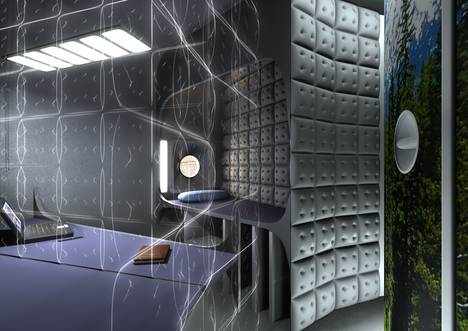 [Image: ANY Design Studios, via Building Design]. [Image: ANY Design Studios, via Building Design].
"What would it be like to spend nearly two Earth years at the Martian north pole," we're asked, "a place where darkness falls for nine months of the year, carbon dioxide snow flutters down in winter and temperatures drop to a chilly minus 150 centigrade?" I, for one, think it would be wonderful.
 [Image: ANY Design Studios, via Building Design]. [Image: ANY Design Studios, via Building Design].
The architecture itself is "a self assembling six module robotic design on tracked landing legs." It's thus a cluster of smaller buildings that, together, "would allow for ten people to live indefinitely at the pole."
The architects behind the project go on to explain that they "have also been exploring the possibility of reproducing programmable Earth environments in a room we have called the ‘Multi Environment Chamber’. Settlers on Mars may well be able to make themselves a cup of tea and settle into a chair with the sun gently warming their skin, cool breezes, and the sound of songbirds of an English orchard on a warm July afternoon" – assuming that such an experience wasn't precisely what you were trying to get away from in the first place.
These "programmable Earth environments," though, should undoubtedly include a setting in which you are sitting in a room in southern California, which has been kitted out to look like a Martian base – inside of which a man sits, reminiscing about a room in southern California that he once decorated to look like a Martian bungalow... Which would be referred to as the interplanetary architecture of et cetera, et cetera, et cetera.
Phrased otherwise, of course, all of this would simply be an inversion of what William L. Fox describes in his recent book, Driving to Mars. There, Fox writes about "the idea of practicing Mars on Earth" – which means simply that, even as I write this, there are teams of astronauts on a remote base in northern Canada, acting as if they are already surrounded by Martian topography.
It's a form of psychological training: act as if you have already arrived.
So you simply turn that around and find, here, that anyone living inside this "self assembling six module robotic design on tracked landing legs" will really be "practicing Earth on Mars."
Act as if you never left.
But why not practice, say, Jupiter, instead? Why not be even more ambitious and use each planet in this solar system as a base from which to simulate the rest?
Or you could just abandon simulation altogether, of course, and experience Mars as Mars.

It's interesting, though, in this context, to look at the naming practices used by NASA through which they claim – or at least label – Martian territory. Landscapes on Earth toponymically reappear on the Martian plains; there is Bonneville Crater and Victoria Crater, for instance; there is Cape Verde and a cute little rock called " Puffin."
Mars is an alien landscape, then, in everything but name.
Even more fascinating, at least for me, is the small range of Martian hills now "dedicated to the final crew of Space Shuttle Columbia." Accordingly, these hills now appear on maps as the Columbia Hills Complex. An entire landscape named after dead American astronauts? Surely there's a J.G. Ballard story about something exactly like this?
Then again, according to one reviewer: "A story by J.G. Ballard, as you know, calls for people who don't think." Uh oh.
(Note: For more on Martian architecture don't miss the unbelievably weird proposal behind Mars Power!, discussed earlier on BLDGBLOG).
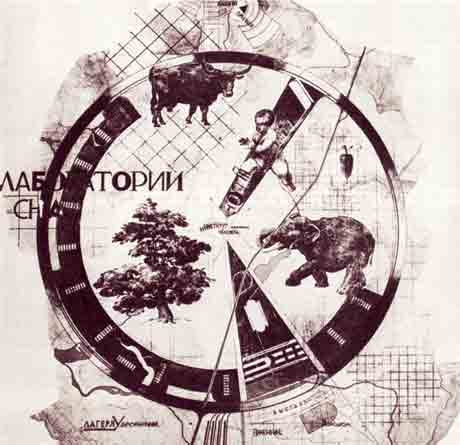 [Image: A "garden suburb" outside Moscow. Via Cabinet Magazine]. [Image: A "garden suburb" outside Moscow. Via Cabinet Magazine].In the new issue of Cabinet, we read how, following the implementation of Stalin's first Five-Year Plan – and in the wake of food rationing and extended work hours – "the shock-troops of Communism were edging perilously close to physical and mental exhaustion: what they needed was rest." Soviet authorities thus "announced a competition to design a garden suburb outside Moscow, where workers could be sent to recuperate from the strains of factory labor." Without getting into specifics – for that, be sure to pick up a copy of the magazine, issue #24 – one detail about the garden suburb that I particularly love, and that the article's author specifically highlights, was a sort of colosseum of slumber. A dream academy. Designed by Konstantin Melnikov, the building was a purpose-built structure referred to as the "Sonata of Sleep." 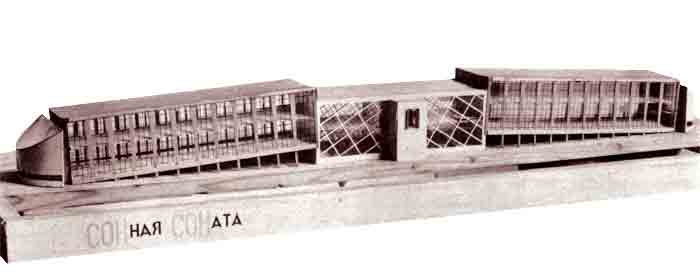 [Image: Konstantin Melnikov's "Sonata of Sleep." Via Cabinet Magazine]. [Image: Konstantin Melnikov's "Sonata of Sleep." Via Cabinet Magazine].Specifically, we're told, "the building consisted of two large dormitories either side of a central block," and the dormitories each "had sloping floors." This would "obviate the need for pillows." Even more amazing – or is it absurd? – we read: At either end of the long buildings were to be situated control booths, where technicians would command instruments to regulate the temperature, humidity, and air pressure, as well as to waft salubrious scents and "rarefied condensed air" through the halls. Nor would sound be left unorganized. Specialists working "according to scientific facts" would transmit from the control centre a range of sounds gauged to intensify the process of slumber. The rustle of leaves, the cooing of nightingales, or the soft murmur of waves would instantly relax the most overwrought veteran of the metropolis. Should these fail, the mechanized beds would then begin gently to rock until consciousness was lost. While all this certainly sounds ambitious enough, apparently "Melnikov's original impulse had been much more far-reaching." His original dream had been to create an Institute for Changing the Form of Man. The whole article is awesome, frankly, encompassing the resurrection of the dead, a house designed by Melnikov in which residents felt as if they "were floating in thick golden air," and further thoughts about how Melnikov "recombined industrial iconography into a series of spatial adventures," most notably with a building that was "a delirium of gigantic stairways and roller bearings." 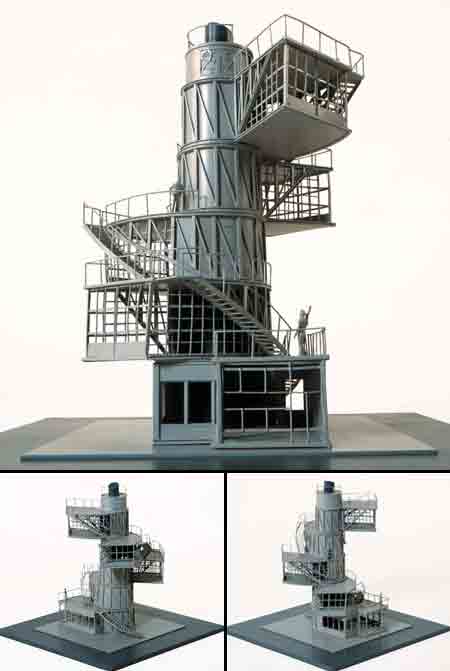 [Image: Konstantin Melnikov's "Leningrad Pravda" tower, as modelled by R. Notrott]. [Image: Konstantin Melnikov's "Leningrad Pravda" tower, as modelled by R. Notrott].While I'm on the subject, though, don't miss this page full of Melnikov's other architectural projects, including the tower, pictured above, where "each floor should turn around the central core," and this outrageous parking garage, to be constructed as a bridge in Paris, over the Seine. Note the bronze, Oscar-like statues holding up either end of the structure. (Thanks to Leah Beeferman for emailing me the first two images, hot off the press from Cabinet).
Another cool project from Domus, this time a "vertical cemetary" whose "commitment to quality is eternal." 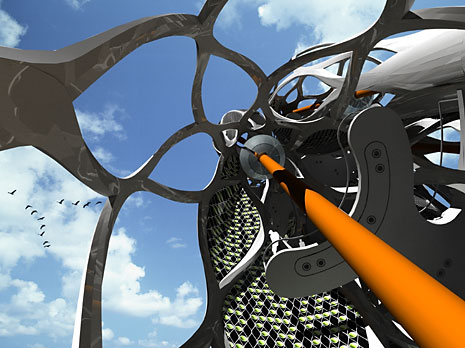 [Image: Via Domus]. [Image: Via Domus].Though it looks like something out of Perdido Street Station, it's really a skyscraping extension to the Memorial Necrópole Ecumênica, "a vertical cemetery established in Santos in Brazil in 1983." This futuristic, insectile extension "will create another 25,000 niches, set inside a 108-metre-high tower block that will complete the complex." It will be circled by birds, looming alien on the horizon. 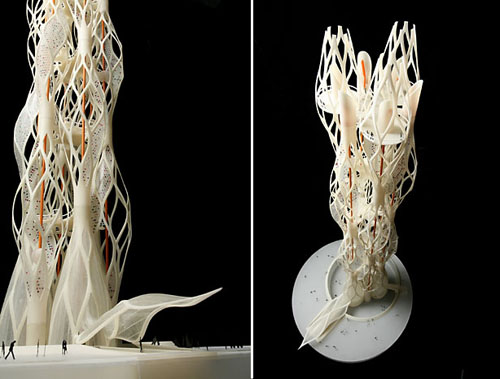 [Image: Via Domus]. [Image: Via Domus].Quoting the article at great length: The vertical cemetery is particularly widespread in Brazil and is also beginning to be used in other places: the Panteón Memorial Towers complex, which consists of 13 towers in a vaguely deconstructivist style, has recently been presented at Bogotá in Colombia and sparked debate concerning changes in funeral rituals related to the social changes that have taken place over the last 30 years. In the South Korean pavilion at the last Venice Architecture Biennale, the project The Last House by architect Chanjoong Kim (founder of System Lab) addressed the same notion, bringing it into line with more contemporary architectural styles and approaches and drawing on a zoomorphic language that echoed systems of vascular circulation. Architecture appears swift to take the opportunity to address a new area where death creates a market, on the borderline between consumerism and entertainment. Personally, I think it will soon be covered in plastic bags, snagged from the air, and within ten years it will host a bungee-jumping platform. Then, fifteen years after the tower is completed, a Brazilian George A. Romero will make a terrifying new version of Night of the Living Dead, in which all the corpses come back to life... falling to the ground in packs, then crawling away into the darkness. 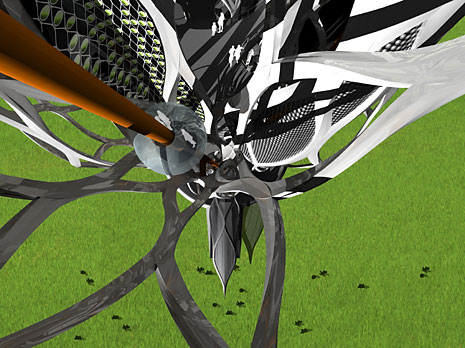 [Image: Via Domus]. [Image: Via Domus].More images are available at Domus, and a few more thoughts on such projects can be found at we make money not art. (Elsewhere: " The Hanging Cemetary of Babylon").
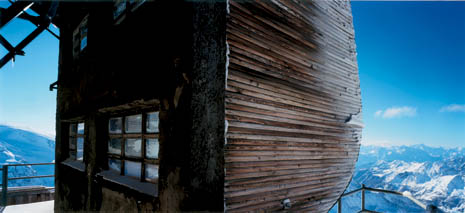 [Image: Carlo Mollino's "architectural solution for extremely high altitudes." Via Domus]. [Image: Carlo Mollino's "architectural solution for extremely high altitudes." Via Domus].Last year, Domus introduced us to an "architectural solution for extremely high altitudes." But it's not another weird, home oxygen system; it's a derelict ski lift relay station, designed by Carlo Mollino – who apparently once said: "Everything is permissible as long as it is fantastic."  [Image: Via Domus]. [Image: Via Domus].The ski lift itself was meant to cross upward through the Alpine sky, from mountain top to mountain top, eventually alighting upon the crest of the Matterhorn. As such, it was part of a much larger mountain sports complex – or distributed "micrometropolis," as the article describes it – for prestigious (and wealthy) winter athletes. Wonderfully, these structures – located on various peaks and connected by cable cars – were partly inspired by "the Tibetan monasteries of Lhasa as self-sufficient and self-justifying mountain units." Mollino himself wrote, referring to this project: "I believe this construction represents an answer to the question of architecture at very high mountain altitudes, and that it is also a new constructional concept. It is literally anchored in the rock, which had to be dynamited in order to create the albeit partial support platforms. All the rest is cantilevered.” 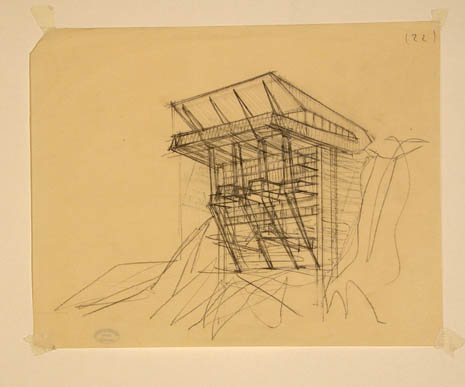 [Image: A sketch by Carlo Mollino. Via Domus]. [Image: A sketch by Carlo Mollino. Via Domus].However, "a secret passageway into the glacier" was also constructed; this was a jagged corridor filled with stairways and machinery that Domus refers to as "the famous rock tunnel." More poetically, they add, it's "a tunnel through the rock of one of Europe’s geological attics." 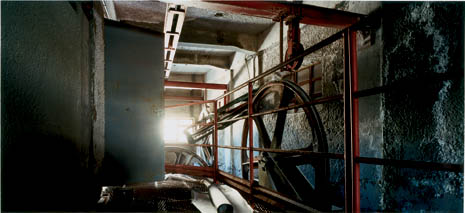 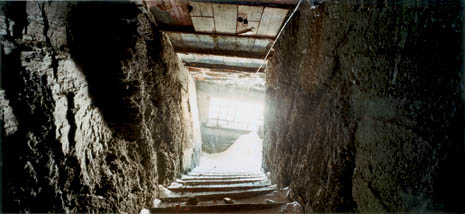 [Images: Inside "the famous rock tunnel," that "passageway into the glacier." Via Domus]. [Images: Inside "the famous rock tunnel," that "passageway into the glacier." Via Domus].Though I want so badly to learn that a manmade labyrinth of tunnels and passageways has been blasted through the highest mountains of the Alps – perhaps even possible to ski through – it seems that this "famous rock tunnel" doesn't go very deep, and that it houses nothing but enginery for the ski lift, bobbing noisily in the wind outside. But there's just something so incredibly evocative about an abandoned network of Alpine ski lifts. You arrive in a small town in Switzerland, say, having traveled there to research tectonic stress in the rocks of southern Europe – how that continent's ongoing collision with Africa results in magnificent lumps of folded rock, rising miles into the air. Your guidebook mentions a specific geological formation worth the time if you can reach it, because those rocks have neither been seen nor photographed since the early 1950s. Turns out, the only way up there – and the rocks are way up there: three or four mountains away, in the wind, ice, and weather – is to take a series of abandoned cable cars. No one is even sure how well the machinery works, but, after a few days' tinkering, using a dozen cans of WD-40, you manage to get the thing back on track. You pack a lunch, put on some gloves, and you bring a new flashlight – and some granola bars, just in case. And then you ascend, alone, taking photographs, as you pass from one abandoned outpost to the next, gliding through cantilevered architectural structures, each more fantastic than the one before. By midday, you have arrived at a spectacular cluster of buildings, now abandoned to the snow for over 60 years – but, of course, at that instant, the cable car jams. Gingerly, you step out. Looking back, you can't even see the village where you started; looking ahead, you can't see the peak you've been looking for. The cables just sort of disappear, sagging and forlorn, covered in icicles, like thin wires between distant cliffsides. Soon, it's rather late. 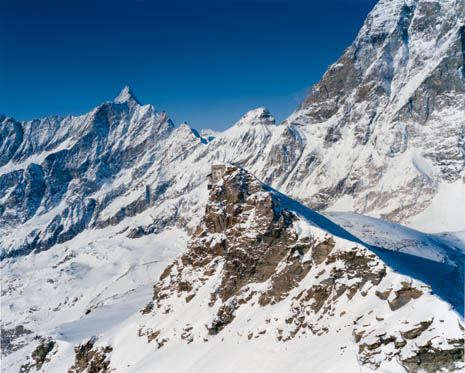 [Image: The Alps. Via Domus]. [Image: The Alps. Via Domus].You crawl into one of the empty buildings in an effort to stay warm – because, outside, the wind has picked up – but you notice that, behind the wood panelling in the back, there's some kind of opening, or even a cave. Or at least there's something: you can't quite tell what it is. Crawling over to investigate, flashlight in hand, you realize it's not a cave at all, but a manmade tunnel. And it extends downward, at a sharp angle. Looking closer, you see footprints. You enter.
 [Image: Tomas Saraceno, via Domus]. [Image: Tomas Saraceno, via Domus]."A sun is rising behind a large glass surface among the trees," Daniel Birnbaum writes in Domus, and that sun's "bright light is reflected in the water. Huge balloons hover in the air, some transparent, others lit from within. Hundreds of people gather on the small green island at night. What kind of strange place is this?" 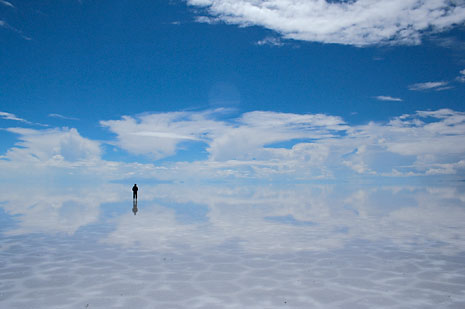 [Image: Tomas Saraceno, via Domus]. [Image: Tomas Saraceno, via Domus].This "strange place" is actually "a small island in a river running through a large European city." Specifically, if somewhat disappointingly, it's an art institute called "the new Portikus," and it's located in Frankfurt, Germany. As it happens, the new Portikus is in the midst of a long run of art installations, and so the sun we just saw "rising behind a large glass surface among the trees" is really a project designed by Olafur Eliasson’s Light Lab. The project is "visible at night from across the city," and is part of what Birnbaum calls "a solar lab." After all, he adds, all of the artworks in this series "will all relate to the notion of heliotropism." 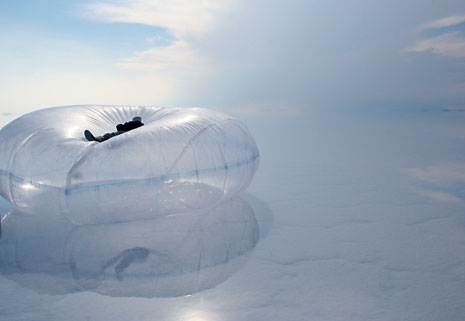 [Image: Tomas Saraceno, via Domus]. [Image: Tomas Saraceno, via Domus].However, artist Tomas Saraceno, also exhibiting at Portikus, is "more interested," we read, in how people could start "living in the skies." Saraceno thus "explores the possibilities of air-borne housing as a conceivable solution to the problems of population growth and rapidly changing climates." Elsewhere, in an interview with Stefano Boeri and Hans Ulrich Obrist, Saraceno says: "Up in the sky there will be this cloud, a habitable platform that floats in the air, changing form and merging with other platforms just as clouds do. It will fly through the atmosphere pushed by the winds, both local and global... in a permanent state of transformation, similar to nomadic cities." In other words, it'll be a bit like the Helicopter Archipelago... In the same interview, Saraceno then describes another project called the Flying Garden. The Flying Garden will be an "invasion" of the sky, "made up of plants, humans and animals." For instance, "there will be 'air plants'," he says, taken "from the genus Tillandsia. Native to South America and Africa, these are true air plants: they derive all their nutrition from the air, imbibing rain and dew and whatever nutrients the air brings to them through their leaf tissues. There are no roots for water and nutrient uptake so they are quite air-sufficient." This actually reminds me of an image I've had in my head for several years now: which is a forest, growing at its own faunal pace, over years, decades, even centuries, yet all the plants are rooted in transparent soil – clear hillsides like plastic or glass – so you can actually sit there in the sun, reading Charles Darwin, everyday, every week, watching those slow and ancient roots push deeper and deeper into the earth. Worms crawl, as if through space, forming tunnels – underground landscapes of air. After the sun goes down, you walk out into the middle of the woods with a flashlight and you shine it straight down through the surface of the earth, illuminating tangles of roots and buried streams.
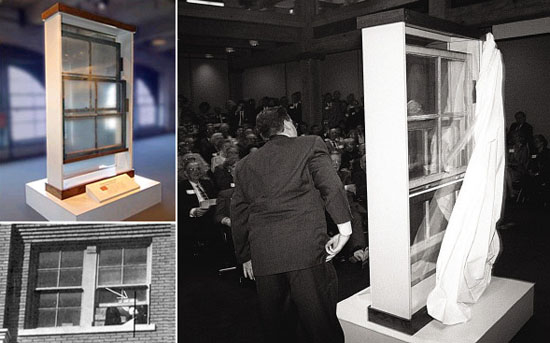 [Image: The window through which JFK was shot, recently purchased for over $3 million on eBay]. [Image: The window through which JFK was shot, recently purchased for over $3 million on eBay].Leaving aside for now whether or not this is the real deal, the window through which JFK was assassinated has been purchased on eBay for more than $3 million. "The starting price was just $100,000," the BBC reports, "but bidding was brisk and the item eventually fetched $3,001,501." Why was it available for purchase at all? Well, apparently, "the window of the Dallas building was removed shortly after the assassination because people were stealing bits of it." They presumably then took those bits home as macabre souvenirs – latter-day relics, perhaps carefully enshrined in secret temples to American history, next to devotional photographs of Elizabeth Taylor and Marilyn Monroe. 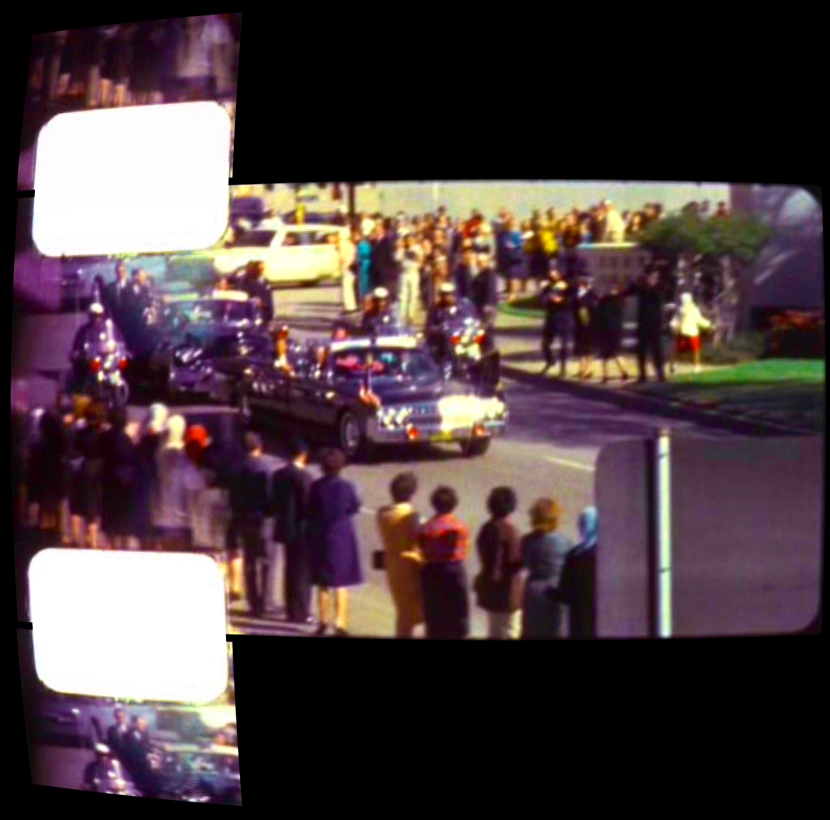 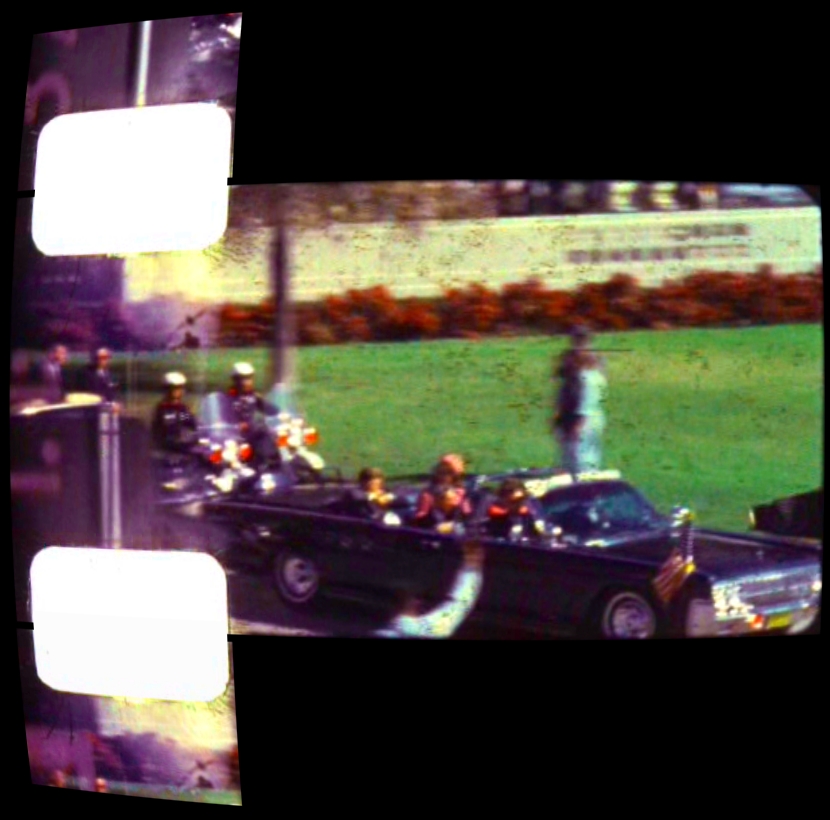 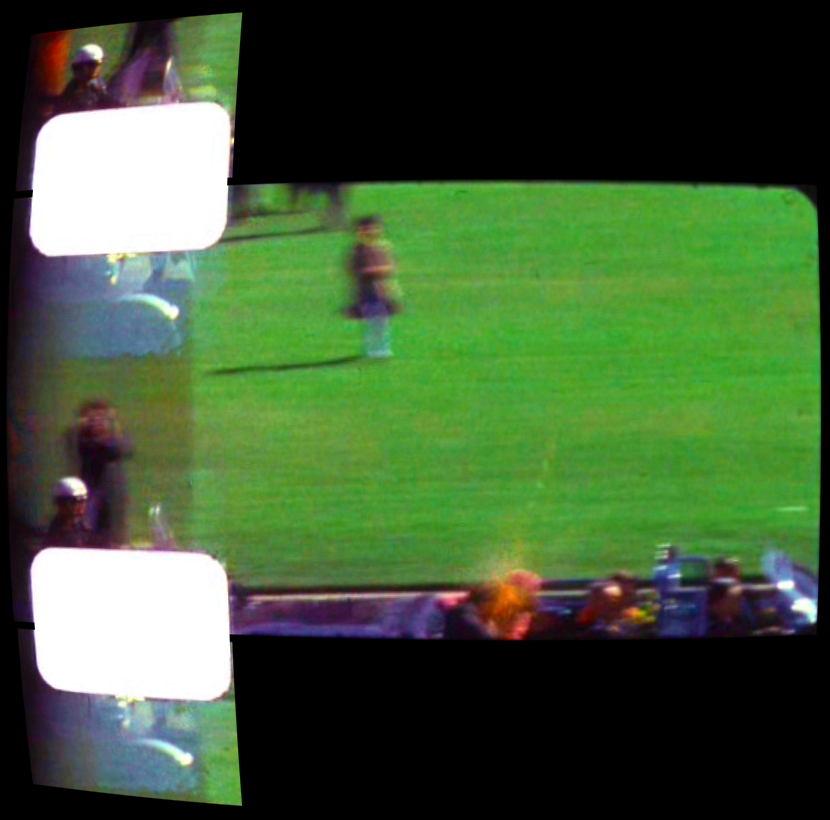 [Image: Three frames from the infamous Zapruder film, an amateur tourist reel that captured the assassination of JFK in Dealey Plaza, Dallas, 1963; via Assassination Research]. [Image: Three frames from the infamous Zapruder film, an amateur tourist reel that captured the assassination of JFK in Dealey Plaza, Dallas, 1963; via Assassination Research].No one is entirely sure, however, if this particular window is authentic; for instance, the BBC mentions a few "conspiracy theorists" who say that it cannot possibly be the real window – after all, they claim, "a man from Tennessee bought the building years ago and took the window with him when he left town." What he did with it next just adds to the mystery. Perhaps you've even looked through it, whilst visiting your parents' neighbors in Memphis; or perhaps you saw a man with a Southern accent hanging out at a gas station in New Mexico, and he was transporting a large window in the back of his minivan. Looking closely, you saw that it was secured with several padlocks, and the man was carrying a stun-gun... Perhaps this mysterious dealer in architectural fragments is actually amassing items for his future Museum of Assassination, in which pieces of architecture, historical documents, and associated weaponry will be put on display. A complete, hyper-realistic simulation of Dealey Plaza is being constructed out back. 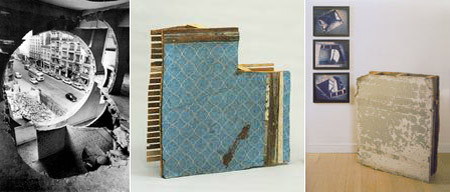 [Image: A "building cut" by Gordon Matta-Clark, along with two "Bronx Floors"]. [Image: A "building cut" by Gordon Matta-Clark, along with two "Bronx Floors"].In any case, what all this actually made me think of was New York artist Gordon Matta-Clark's project " Bronx Floors." To produce artworks like these, Matta-Clark "would chainsaw large circles or other shapes in abandoned buildings and exhibit both a photograph of the building after the operation and the parts that had been removed" (emphasis added). In other words, many of the "objects" that Matta-Clark displayed in New York City art galleries were really decontextualized fragments of existing buildings – including, of course, several Bronx floors. These mobile pieces of real architecture – a fever of walls and floors on the loose in New York City – became instant works of sculpture, somewhere between a readymade object, archaeological remains, and a kind of experiment in found architecture. So what's interesting about the JFK window, at least for me, is that it seems to exist – purposefully or not – as a Matta-Clark-like sculpture, a " building cut" if there ever was one. Perhaps we may even find that Gordon Matta-Clark did not die of cancer at all – in fact, he moved to Tennessee, only to purchase, years later, a certain building in Dallas, Texas... On the other hand, the auctioning off of JFK's fatal window also opens up the possibility that we could chainsaw, chisel, or otherwise reclaim – i.e. steal – historically important bits of architecture, removing them from their original contexts and exhibiting them elsewhere. The balcony over which Michael Jackson dangled his baby in Berlin; the terrace from which Juliet addressed Romeo; the windows through which administrators were defenestrated in Prague. Perhaps we could even re-assemble all these into a complete, if eclectic and quite controversial, new building – add the JFK window as the coup de grâce – and you've got a 21st century version of Sir John Soane's Museum in London. But, of course, archaeology is full of such acts of structural burglary. Whole temples and friezes and doorways and rooms have been removed and transported elsewhere. Just ask Lord Elgin – or, for that matter, ask the Getty. In light of all this, then, are we witnessing some new Lord Elgin of the 21st century, raised on the novels of J.G. Ballard, as he or she begins a new quest to collect pieces of architectural morbidity? The sale of JFK's window would thus be the opening salvo in this death-obsessed archaeology of tomorrow.
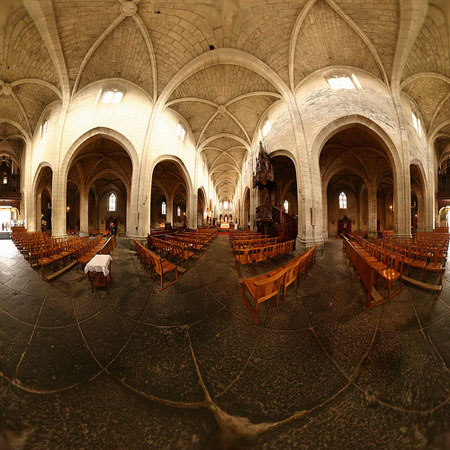 [Image: "Adams in Saint Flour Cathedral," a 360°x180° panorama by Seb Przd]. [Image: "Adams in Saint Flour Cathedral," a 360°x180° panorama by Seb Przd].Flickr user Seb Przd has been re-mathematizing his photographs of French cathedrals, using a program called MathMap. The results are delirious whorls of rock and decoration, space folded onto itself and circled round again to match up with itself at the beginning. All very M.C. Escher-esque – but nonetheless exhilirating. 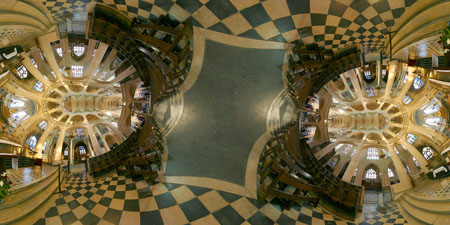 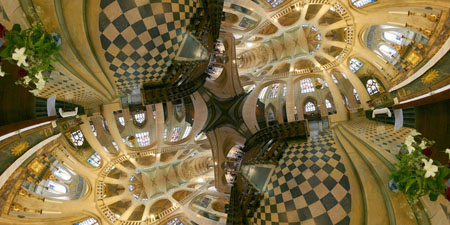 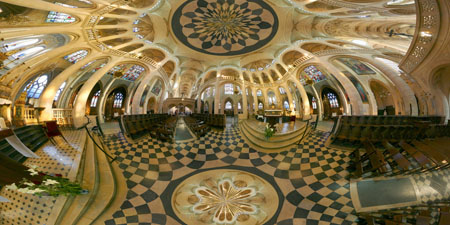 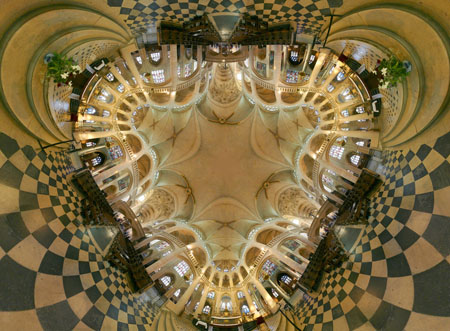 [Images: "Saint Etienne Two Times," taken inside Saint Etienne du Mont, Paris; another view of Saint Etienne du Mont; inside the same church; and a final view inside Saint Etienne du Mont, Paris. All photographs by Seb Przd]. [Images: "Saint Etienne Two Times," taken inside Saint Etienne du Mont, Paris; another view of Saint Etienne du Mont; inside the same church; and a final view inside Saint Etienne du Mont, Paris. All photographs by Seb Przd].Further clicking took me through to an entire Equirectangular Pool on Flickr, and further still to a specific Equirectangular set by another Flickr user called HamburgerJung. In particular, I like his shot " Treppe." However, even then I found myself clicking back to look at images by Seb Przd, including " On the side of the cathedral," " Don't drink and pray," and " Notre-Dame de Reims." If you look at enough of these, though, you begin to see that specific styles of architecture are better than others when it comes to this sort of optical distortion. The old stone cathedrals of Europe are fantastic, for instance, but modern – even art nouveau – structures look pretty lame, frankly. I also think meadow shots, or straight-up landscapes, just look really gimmicky. So perhaps we should send Seb Przd, armed with a camera and loads of film, on a six month trip through Europe, photographing every Gothic cathedral from within... A kind of optical encounter between Christianity and mathematics.  [Image: "The Ceiling and Columns of the Cathedral" by Seb Przd]. (Discovered via MetaFilter). [Image: "The Ceiling and Columns of the Cathedral" by Seb Przd]. (Discovered via MetaFilter).
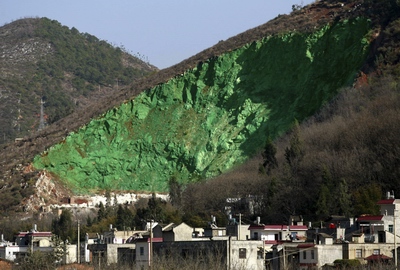 [Image: REUTERS/China Daily]. [Image: REUTERS/China Daily].A mountain quarry in the county of Fumin, China, has been " artificially painted green by the local forestry bureau" as a way "to simulate planted trees." Doing this apparently cost $51,000. "Workers who began spraying Laoshou mountain last August told villagers they were doing so on orders of the county government but were not told why," the Associated Press reports. "Some villagers guessed officials of the surrounding Fumin county, whose office building faces the mountain, were trying to change the area's feng shui" – others think they were told to do it by Pruned. That, or they were just responding over-literally to the horrific slogan of chemical giant Sherwin Williams – who exhort their customers to " cover the earth" with paint. (Via things magazine).
 [Image: Courtesy of NASA/Pat Rawlings/SAIC, via New Scientist]. [Image: Courtesy of NASA/Pat Rawlings/SAIC, via New Scientist].Proteins harvested from inside the human ear could soon power space stations on Mars. "Astronauts' spacesuits may one day be covered in motion-sensitive proteins that could generate power from the astronauts' movement," New Scientist reports. "Such 'power skins' could also be used to coat future human bases on Mars, where they could produce energy from the Martian wind." Surely, though, biomechanical protein coats like these would also be architecturally useful here on earth? On these shacks, for instance?  [Image: Courtesy of NASA/John J. Olson, via New Scientist]. [Image: Courtesy of NASA/John J. Olson, via New Scientist].To make this work, then, researchers in Cambridge, MA, have been "focusing on a protein called prestin, which is found in the outer hair cells of the human ear. In the cell membranes of these cells, prestin converts electrical voltage into motion, elongating and contracting the cell. This movement amplifies sound in the ear. However, prestin can also work in reverse, producing electrical charges in response to mechanical stresses, such as tiny vibrations." Stunningly, Northwestern University actually "patented the prestin molecule in 2003," claiming, as they did so, that prestin "may be 10,000 times more efficient at generating power than the best manmade material." Ironically, of course, prestin is, in a way, manmade? In any case, if I clean my ears and damage some prestin molecules, do I owe Northwestern University money? And what happens if you wake up one day to find that someone has patented your hands? Perhaps someday we'll read about the Laboratory of Patented Anatomy – housed, yes, at Northwestern University.
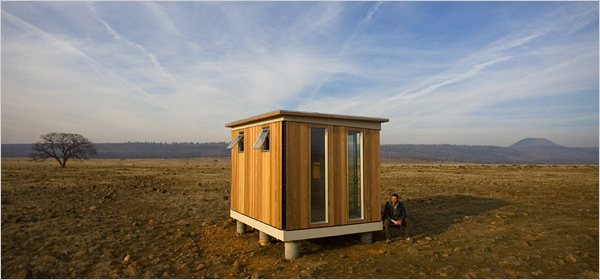 [Image: A 120-square-foot house designed by Modern Cabana; photo by Peter DaSilva for The New York Times]. [Image: A 120-square-foot house designed by Modern Cabana; photo by Peter DaSilva for The New York Times].Today, the New York Times points our attention to the rise of small architectural structures – something surely any long-term reader of Inhabitat knew about years ago. In any case, the article claims, there is now a "wave of interest in such small dwellings," chosen in lieu of, say, a brand new McMansion full of closets you never enter and weird nightmares about sports equipment you bought ten years ago but never used. "Seldom measuring much more than 500 square feet," the Times continues, these micro-houses "offer sharp contrasts to the rambling houses that are commonplace as second homes." For instance, we learn that to "compensate for the lack of interior space," some clients now "cook, entertain and, for the most part, live outdoors." Most importantly, though: Minimal square footage means reduced maintenance costs, less upkeep and reduced energy consumption. Prefabricated and pre-built models can require little or no site preparation, which means no anxious weekend drives to the country to make sure construction is moving along. Add to this an element of instant gratification (once the planning stage is over, most houses go up in days, even hours, and many are delivered, turn-key, to the site).
Choosing a house starts to resemble buying a car. "In theory," we're told, "this could contribute to an increase in sales of undeveloped land." But is that really such a good thing? It depends on what form your "undeveloped land" takes. Is it virgin forest? Or a Home Depot parking lot? Or your own backyard? 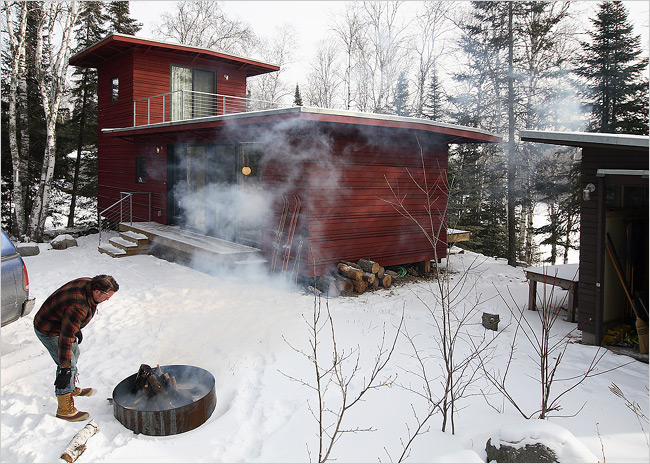 [Image: "Scott and Lisa McGlasson’s 700-square-foot weeHouse from Alchemy Architects in northern Minnesota." Photo by T.C. Worley for The New York Times]. [Image: "Scott and Lisa McGlasson’s 700-square-foot weeHouse from Alchemy Architects in northern Minnesota." Photo by T.C. Worley for The New York Times].While reading all this, however, I was reminded of an ongoing theme in medieval – for lack of a better word – Japanese poetry, where the poet's own cloistered 10x10 living space becomes a recurring sign and reference in the poetry itself. Typically, I can't find a single example of what I'm talking about – but scouring my old notebooks here, I have found some poems that are so good, and topically relevant, that I thought I'd just type them out anyway. So: some poems, inspired by small living spaces. Sorry! "It's snowed!" I see, opening up the shutters to the light of dawn – when, from next door, comes the sound of a neighbor doing the same thing. —Reizei TamesmasaJust biding my time night after long autumn night, I have watched the moon – with not a thing else to do but sit here and grow old. —Nijo TamesadaIn this mountain village where I've given up all hope of visitors, how drab life would be without my loneliness —SaigyoI remember when I was young reading alone in the empty hall, again and again refilling the lamp with oil, never minding then how long the winter night was —RyokanClear icy water races straight down the mountain and into my tub —IssaBetween window screens, a tiny hand reaches out to touch the spring rain —ToraiIf I can find nowhere fit to live, then let me live nowhere – in this hut of sticks as flimsy as the world itself. —SaigyoUnfortunately, when I moved out to LA I didn't bring along my copies of Flowing Traces and The Karma of Words – so I can't offer you much more; but each of those books contains at least one essay about the poetry and symbolism of the 10x10 room, and the literary form that "living small" eventually fostered. Of course, if you've read one of them, or have some quotations I could use, let me know... Meanwhile, the New York Times writes, the actual cost of these "tiny houses" depends on what you want. Prices vary according to things like "degrees of finishing, who does the building, types of materials and design options. In general," we're advised, "count on spending anywhere from $35 a square foot for a very basic structure to more than $200 a square foot for designer models built with specialized or luxury materials." But then it's yours: you own it. A place to sit and count fireflies and be alone with a window and a floor – until your friends come by and drink all your wine and put Scorn records on till the police show up. Even if you live in the middle of a desert, with a skylight, and 20 acres, and the stars.
 Well, I'm not in New York as it turns out, and I won't be heading that way. Instead, I got to spend three hours sitting on a plane this morning before the captain announced that, first, the plane would be delayed due to bad weather in New York; then that the plane would be delayed yet again; then that the flight itself had simply been cancelled – and so we should all get up, go home, and take our high blood pressure along with us... Of course, that also means I won't be presenting at the Architectural League tomorrow; and that I will, in fact, be posting here on BLDGBLOG at a more or less regular pace. As it happens, there are heaps of things of write about – but I'd rather be in New York, frankly. Eating bagels and discussing the role of independent architectural organizations in the 21st century and staying in a hotel that, apparently, had a heated indoor pool. Oh well.
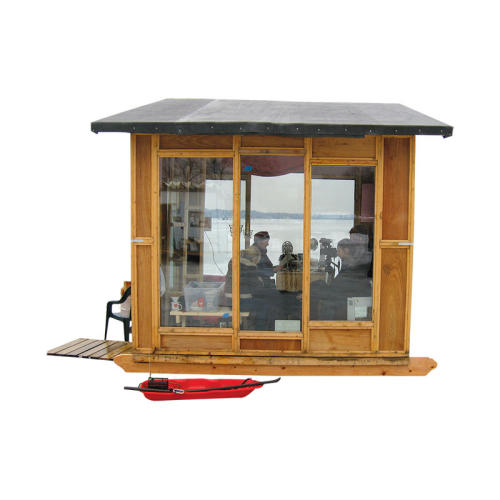 [Image: Courtesy of the Art Shanty Projects, via Metropolis]. [Image: Courtesy of the Art Shanty Projects, via Metropolis].Though it's hidden behind a subscriber-only link, I've got a short article in the new issue of Metropolis. So if you're standing in the check-out line at the supermarket and you need something to read...  [Image: Courtesy of the Art Shanty Projects, via Metropolis]. [Image: Courtesy of the Art Shanty Projects, via Metropolis]."For the past four winters," the article goes, "a kind of sci-fi skid row has sprung up on the temporarily frozen surface of Medicine Lake, in the western suburbs of Minneapolis." The structures have all been put there by the Art Shanty Projects, an "annual folk-architecture experiment" that now "features nearly two dozen cabins – each a unique variation on the traditional Minnesotan ice-fishing shed." Organized and run by Peter Haakon Thompson and David Pitman, this instant city on ice – part community festival, part architectural happening – includes a long list of participating artists and their often wildly different little buildings. 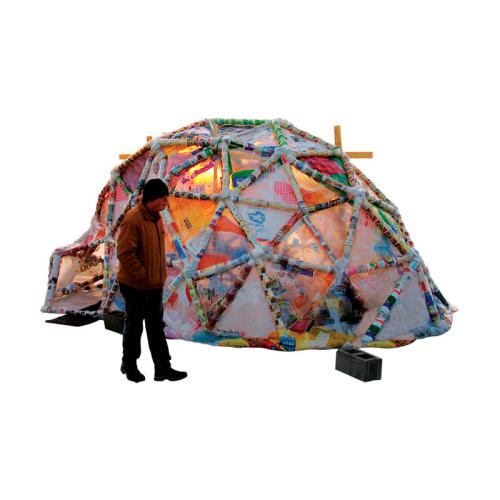 [Image: Courtesy of the Art Shanty Projects, via Metropolis]. [Image: Courtesy of the Art Shanty Projects, via Metropolis].There are teahouses and karaoke rooms, a pinhole camera shanty and a place to knit scarves; there's a functioning post office, a shack for misfit toys, and even a science shanty "themed around limnology – the study of lakes." But one of my favorites this year is actually the shanty in which you can "engage the community in a conversation about... cactus." Last winter, the shanties included a structure made of ice shells by the folks behind Materials & Applications; there was an artificial drumlin; and there was a " work of art" produced by local high school students – who also supplied this memorable description of the event itself: the Art Shanty Projects is a "five-week exhibition of architecture, performances, science, art, zombies, spear-fishing, videos, robots, pinhole cameras, sculpture, knitting, readings and karaoke." There was even a glass-blowing shanty and a peepshow on ice. 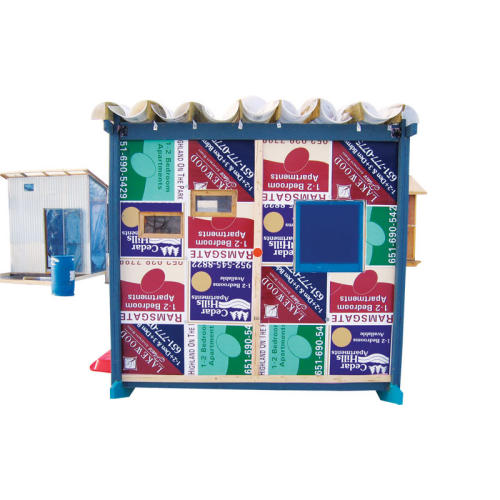 [Image: Courtesy of the Art Shanty Projects, via Metropolis]. [Image: Courtesy of the Art Shanty Projects, via Metropolis].However, if you're hoping to see the shanties in action, be aware that they'll be dismantled on February 17th – three days from now. So hurry. Otherwise, check out the Art Shanty Projects webpage for more info; and pick up a copy of Metropolis if you stumble upon one.
 Last summer, New Scientist reported that a "contaminated lake" in Montana is actually "turning out to be a source of novel chemicals that could help fight migraines and cancer." Berkeley Pit Lake, as it's called, is really a flooded, open pit copper mine. "Dissolved metal compounds such as iron pyrites give the lake a pH of 2.5 that makes it impossible for most aquatic life to survive," New Scientist explains – but "novel forms of fungi and bacteria" have been discovered in its waters. These include "a strain of the pithomyces fungi" that, if used medically, "could block headaches," and "a strain of penicillium fungi" that might help prevent "the growth of lung cancer cells." Somewhat ironically, the scientist behind all these discoveries is now "rushing to identify more of these extremophile creatures before the toxic site is cleaned up." After all, Berkeley Pit Lake is " one of the most toxic mining sites in the western United States" – even if it is a rather unexpected medical resource. An interesting question here, though, is whether the lake's very toxicity has caused some of the cancers its extremophile inhabitants can now help cure. Landscapes of instant karma. Another question: once most of London is flooded, might future scientists stumble upon strange new medical compounds floating in the waters of that inland sea? It could be a new pharmaceutical technique: flood something. Come back in 20 years. Bottle the results.
 [Image: A rendering of the "doomsday vault" by Statsbygg; via the BBC]. [Image: A rendering of the "doomsday vault" by Statsbygg; via the BBC].Last year, New Scientist reported that "a large concrete room, hewn out of a mountain on a freezing-cold island just 1000 kilometres from the North Pole," might represent "the future of humanity." That "large concrete room" is the now somewhat infamous " doomsday vault" in which seeds from all of the world's known crops and plantlife will be stored. The vault – described as "the ultimate safety net for the world’s most important natural resource" – will be constructed "deep inside a sandstone mountain lined with permafrost on the Norwegian Arctic island of Spitsbergen. The vault will have metre-thick walls of reinforced concrete and will be protected behind two airlocks and high-security blast-proof doors. It will not be permanently manned, but 'the mountains are patrolled by polar bears'," we read. In choosing a location and determining other key physical parameters for the project, its designers "ran drastic climate change modelling scenarios, projecting 200 years into the future and factoring in potential increases in water levels due to melting ice from pole to pole." Well, as the BBC reported yesterday, the final design for the vault has been unveiled. 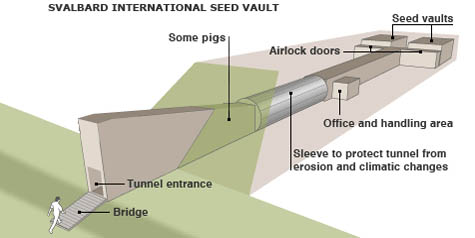 [Image: Inside the vault, rendered by Statsbygg; via the BBC]. [Image: Inside the vault, rendered by Statsbygg; via the BBC].This complex, pictured above, will now "safeguard the world's agriculture from future catastrophes, such as nuclear war, asteroid strikes and climate change. Construction begins in March, and the seed bank is scheduled to open in 2008." Thus, a whole new building type has quietly emerged into architectural history – update your textbooks. Vitruvius would be proud: it's the botanical Arctic Ark-archive. But is Spitsbergen really that safe? Perhaps these seeds should really be stored on, say, the International Space Station? Leaving aside how it would be possible to retrieve them, in the event of a truly global catastrophe, the premise nonetheless reminds me of China's "space seed" project – which seems to have all but disappeared from public discourse. Quoting at length: Plant seeds have been blasted into orbit in the hope that "space breeding" holds the key to improving crop yields and disease resistance. Wheat and barley strains developed by the Department of Agriculture and Food in Western Australia (WA) have just landed back on Earth following a 15-day orbital cruise on board China's Shijian-8 satellite. "Space-breeding refers to the technique of sending seeds into space in a recoverable spacecraft or a high-altitude balloon," said Agriculture WA barley breeder Chengdao Li. "In the high-vacuum, micro-gravity and strong-radiation space environment, seeds may undergo mutation." Surely this must herald the birth of the most interesting era in garden design since Versailles? Cultivating " a number of new species" through genetic interaction with the universe? Or is that the plot of a Donald Sutherland film? After all, we read, China may have "nearly 405,000 hectares of rice fields planted with space seeds and 8,100 hectares of space vegetable growing. An estimate of 243,000 hectares of space rice fields will be added this year." Is this being taught in landscape design courses? Or, more germane to this post: will these space seeds be stored with the rest at Spitsbergen...? (Last year on BLDGBLOG: Seeds of the Apocalypse).
 [Image: "Saturn's moon Tethys bears the brunt of the particles spewing from its neighbour Enceladus – these particles seem to keep its surface clean and bright; photo via NASA/JPL/Space Science Institute and New Scientist]. [Image: "Saturn's moon Tethys bears the brunt of the particles spewing from its neighbour Enceladus – these particles seem to keep its surface clean and bright; photo via NASA/JPL/Space Science Institute and New Scientist]."Particles spewed from Saturn's moon Enceladus are sandblasting neighbouring moons, leaving them sparklingly bright," New Scientist reports. Further: "If life exists beneath the surface of Enceladus, these particles might be spreading it to other moons." The particles in question originate from a " giant water plume" on the moon's south pole. Wonderfully, these same particles go on to create – and continuously replenish – Saturn's so-called E ring. "Internal heat must be driving all this activity," we read, "but the source of the heat remains a big puzzle. Natural radioactive decay in the moon's rocky core might warm the interior just enough to produce a sludgy plume of water and ammonia. This could heat the surface ice just enough to allow water to evaporate slowly." Other hypotheses suggest that Saturn's own gravitational pull is basically sloshing the poor moon into a constant state of eruption – a kind of astronomical vomitorium spraying uncontrollably through space... Perhaps your next semester's landscape design assignment will include giving the Earth one or two of these things.
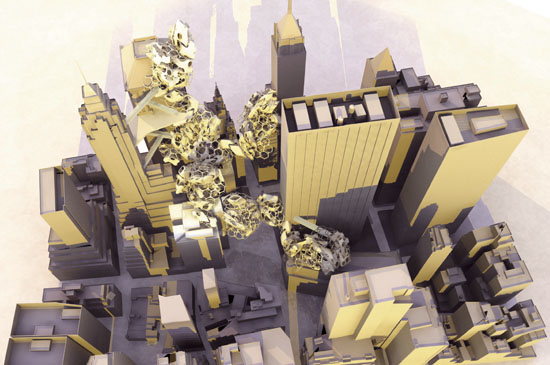 [Image: Para-city by Somnath Ray]. [Image: Para-city by Somnath Ray].Less of a new building type than a kind of architectural fungus spreading across the roofs and walls of the city, Somnath Ray's design for a "skyscraper of the future" won First Prize this year at eVolo Architecture's annual design competition. Called Para-city, Ray's project is meant to take advantage of the unused yet usable space found throughout the city: the massive corridors of air between the other buildings.  [Image: Para-city by Somnath Ray]. [Image: Para-city by Somnath Ray]."With ever-increasing densities and changing programs," he writes, "Para-city grows in the entire three-dimensional space of its host: the existing skyscrapers of the present urban landscape." 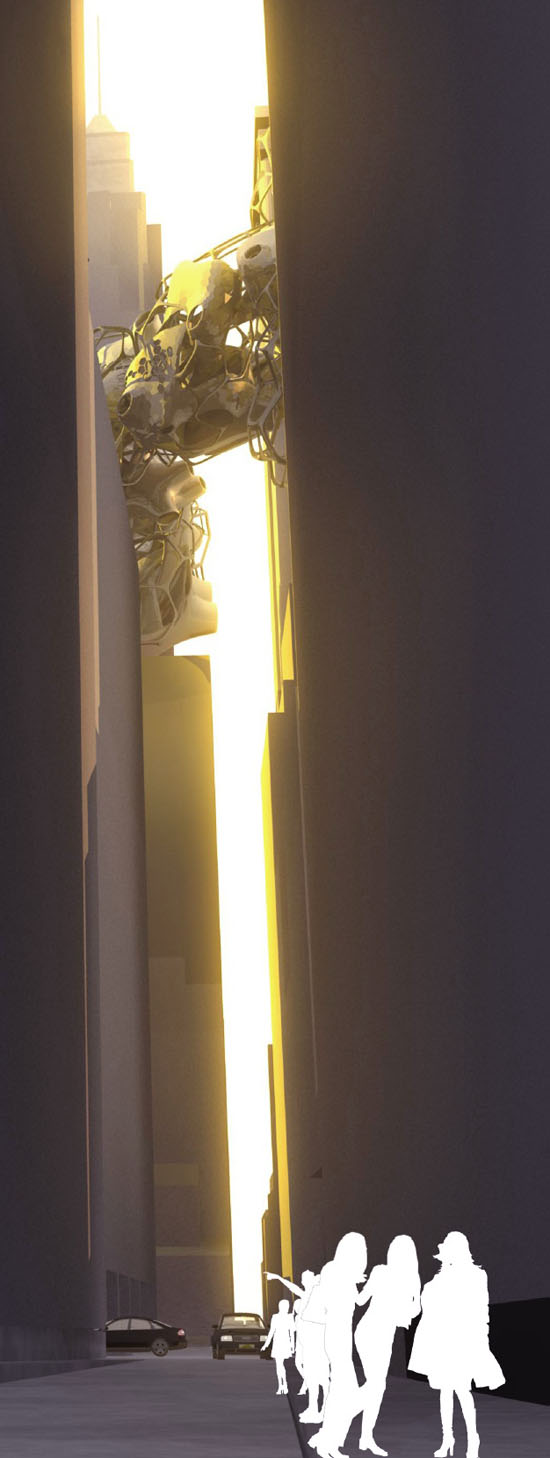 [Image: Somnath Ray]. [Image: Somnath Ray].For other entries and many more images, be sure to stop by the eVolo Architecture competition site – but beware that it appears to have been designed for the purpose of navigational frustration. Never hit the "back" button. If I was Supreme Ruler of the Universe, I would instantly illegalize the use of Flash. Thankfully, a book featuring all the designs should be out by May 2007. (From last year's competition: Skyscraper Futures: Infected Design).
|
|
 [Image: ANY Design Studios, via Building Design].
[Image: ANY Design Studios, via Building Design]. [Image: ANY Design Studios, via Building Design].
[Image: ANY Design Studios, via Building Design]. [Image: ANY Design Studios, via Building Design].
[Image: ANY Design Studios, via Building Design].

 [Image: A "garden suburb" outside Moscow. Via
[Image: A "garden suburb" outside Moscow. Via  [Image: Konstantin Melnikov's "Sonata of Sleep." Via
[Image: Konstantin Melnikov's "Sonata of Sleep." Via  [Image: Konstantin Melnikov's "
[Image: Konstantin Melnikov's "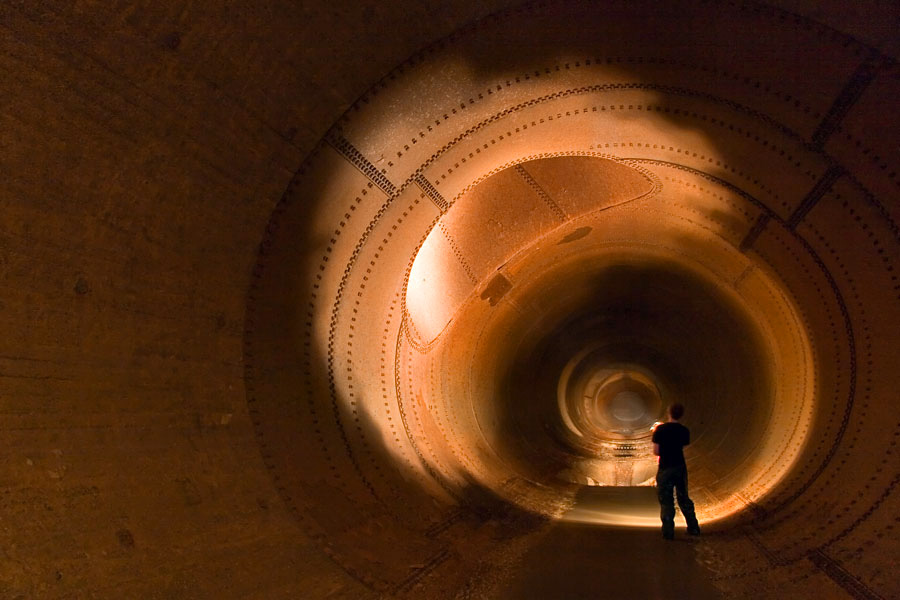 [Image: Inside the riveted curvature and infinite throughways of Ontario's subterranean
[Image: Inside the riveted curvature and infinite throughways of Ontario's subterranean 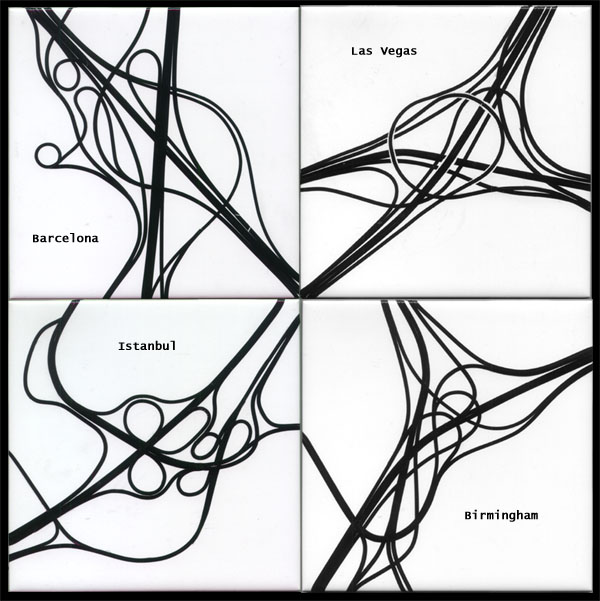 [Image: Four tiles by
[Image: Four tiles by 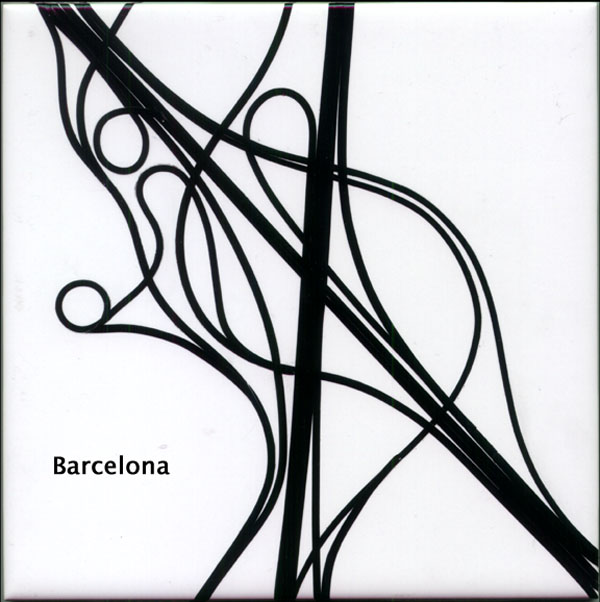 [Image: The Barcelona tile, by
[Image: The Barcelona tile, by  [Image: Via
[Image: Via  [Image: Via
[Image: Via  [Image: Via
[Image: Via  [Image: Carlo Mollino's "architectural solution for extremely high altitudes." Via
[Image: Carlo Mollino's "architectural solution for extremely high altitudes." Via  [Image: Via
[Image: Via  [Image: A sketch by Carlo Mollino. Via
[Image: A sketch by Carlo Mollino. Via 
 [Images: Inside "the famous rock tunnel," that "passageway into the glacier." Via
[Images: Inside "the famous rock tunnel," that "passageway into the glacier." Via  [Image: The Alps. Via
[Image: The Alps. Via  [Image: Tomas Saraceno, via
[Image: Tomas Saraceno, via  [Image: Tomas Saraceno, via
[Image: Tomas Saraceno, via  [Image: Tomas Saraceno, via
[Image: Tomas Saraceno, via  [Image: The window through which JFK was shot, recently purchased for over $3 million on eBay].
[Image: The window through which JFK was shot, recently purchased for over $3 million on eBay].

 [Image: Three frames from the infamous
[Image: Three frames from the infamous  [Image: A "building cut" by Gordon Matta-Clark, along with two "Bronx Floors"].
[Image: A "building cut" by Gordon Matta-Clark, along with two "Bronx Floors"]. [Image: "
[Image: "


 [Images: "
[Images: " [Image: "
[Image: " [Image: REUTERS/China Daily].
[Image: REUTERS/China Daily]. [Image: Courtesy of NASA/Pat Rawlings/SAIC, via
[Image: Courtesy of NASA/Pat Rawlings/SAIC, via  [Image: Courtesy of NASA/John J. Olson, via
[Image: Courtesy of NASA/John J. Olson, via  [Image: A 120-square-foot house designed by
[Image: A 120-square-foot house designed by  [Image: "Scott and Lisa McGlasson’s 700-square-foot weeHouse from
[Image: "Scott and Lisa McGlasson’s 700-square-foot weeHouse from  Well, I'm not in New York as it turns out, and I won't be heading that way.
Well, I'm not in New York as it turns out, and I won't be heading that way. [Image: Courtesy of the
[Image: Courtesy of the  [Image: Courtesy of the
[Image: Courtesy of the  [Image: Courtesy of the
[Image: Courtesy of the  [Image: Courtesy of the
[Image: Courtesy of the  Last summer,
Last summer,  [Image: A rendering of the "doomsday vault" by Statsbygg; via the
[Image: A rendering of the "doomsday vault" by Statsbygg; via the  [Image: Inside the vault, rendered by Statsbygg; via the
[Image: Inside the vault, rendered by Statsbygg; via the  [Image: "Saturn's moon Tethys bears the brunt of the particles spewing from its neighbour Enceladus – these particles seem to keep its surface clean and bright; photo via NASA/JPL/Space Science Institute and
[Image: "Saturn's moon Tethys bears the brunt of the particles spewing from its neighbour Enceladus – these particles seem to keep its surface clean and bright; photo via NASA/JPL/Space Science Institute and  [Image: Para-city by
[Image: Para-city by  [Image: Para-city by
[Image: Para-city by  [Image:
[Image: 


